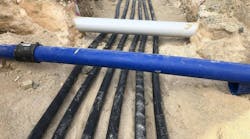New aluminum bus connection system reduces costs at LILCO.
Welding tubular aluminum bus requires specific skills and certification for construction personnel. While welding aluminum bus has provided a consistent and electrically sound connection, some utilities are questioning its cost-effectiveness compared to newer, alternative methods.
Crews at Long Island Lighting Co. (LILCO), Melville, New York, U.S., have welded tubular aluminum in the past, but the utility wanted to locate a connection system that could be used by any construction person without any specialized credentials. LILCO also wanted a connection system that could be used in almost every weather condition without affecting the quality of the connection.
LILCO's search uncovered a new technology for joining tubular aluminum bus that, thanks to advances in tooling technology, reduces construction time. Although the product is in the introductory stages at LILCO, applying the technology to substation construction has already reduced costs.
Known as Powerlok and developed by Deutsch Metal Components, Gardena, California, U.S., the busbar connectors mechanically attach aluminum bus using a compression technique that produces a 360-deg radial swage. The connectors come in different fittings to meet the various substation design configurations. Each connector has a silicon bead (O-ring) around the perimeter inside each opening, which when installed, provides a weather-tight seal between the connector and the busbar. Prior to the connector installation, the busbar is cleaned with an emery cloth to remove any aluminum oxide.
The tooling for the connectors depends on the size of bus being installed. The present system can be applied on busbar sizes ranging from 1-4 inches (2.5-10 cm) in half-inch increments. Changing the head assembly allows for compressing different size bus and can be performed in a matter of seconds. When the connection is complete, an inspection gage is used to assure that the compression is complete and that the connection is sound.
Savings The advantage of the new system is primarily in the speed that a connection can be made. From start to finish, joining two sections of bus can be completed in approximately 3-5 min.
Prior to installing the new connectors in a substation, LILCO performed a small number of test connections to develop a cost-benefit study. The tests showed that the new connectors would increase the efficiency of construction crews and help reduce the overall cycle time for the project. While the individual connectors were more expensive than welded connectors, the labor saved to complete the connection outweighed the material cost differential.
In addition construction personnel need minimal training to begin installation of the connectors, and installation can occur in any weather condition.
Problems Experienced and Overcome Within the past three years, LILCO has installed the new connectors at four substations. While the overall opinion has been favorable, some problems have occurred. When the product was first presented, a limited number of connectors was available, which restricted the application of the new connectors. The variety of connectors fabricated has been expanded and is no longer a concern to LILCO.
More significantly, the ability of construction personnel to handle the tool was a concern. Depending on the angle of the connection being made, managing the weight of the tool became problematic. Deutsch has since modified the tool with a handle that provides for a more user-friendly application of the product.
Assembling and disassembling the power unit from the die head was initially difficult. Modifications to the head made this process more forgiving. Additionally, a stop mechanism was incorporated to eliminate unwanted movement in the head assembly.
One substation application experienced problems with the connectors not being compressed enough. Multiple swages were required to obtain the necessary compression. An investigation revealed that a change in the manufacturing process resulted in a connector that wasn't soft enough for the application. The manufacturer indicated that the problem was identified and the necessary adjustments were made to assure the proper softness.
The exact positioning of the tool on the connector for the proper connection was initially vague to the operator. Recent modifications provide for a guideline on the connector that indicates the correct location for the tool.
Determining when the swage is complete is still somewhat ambiguous. The operator must observe the head assembly as the swage is taking place and determine when the tool has completed its full range of motion. The go gage tells the operator if the swage made is adequate.
Short-Term Leasing is Cost-Effective When LILCO initially investigated this new technology, management assumed the tooling would need to be purchased. However, LILCO discovered that the project schedules and the relative demand for the tool along with the up-front cost meant short-term leasing of the tooling would be more cost-effective. The number of tools available from the manufacturer makes leasing a favorable option. The speed of installation allows two jobs to run concurrently and requires the lease of only one tool.
Conclusion While the new connectors are not the panacea for all substation busbar connections, their use enhances LILCO's ability to join busbar faster, cheaper and in a manner that surpasses all utility quality standards. TDW
Joe Cicalo is an engineer in the Substation Engineering Div. of LILCO, which he joined in 1990. He has the BEE degree from State University of New York, Stony Brook, and the MBA degree from Hofstra University. Prior to joining the Substation Engineering Division, he spent two years as an engineer in Electric Planning.
Swapan K. Dey is manager of the Substation and Transmission Engineering Div. of LILCO, which he joined in 1987. During the last 22 years of his professional career, he has been involved with design, engineering and construction of fossil and nuclear power plants, distribution, transmission and substations. From January 1993 to December 1994, he served as an electric utility advisor for the EPRI Underground Transmission Task Force. He is a member of ESEERCO Power Delivery Committee and a member of IEEE.
Kelly Vaughn is an engineer in the Substation Engineering Div. of LILCO, which she joined in 1987. She has the BEE degree from Manhattan College, Bronx, New York, and the MS degree from Polytechnic University. She spent six years as an engineer in the System Control and Protection Div.

